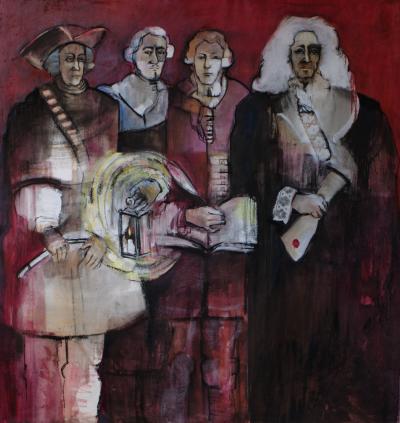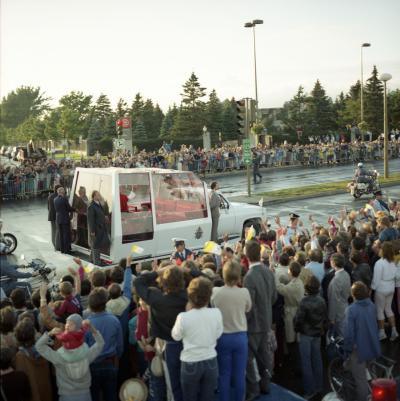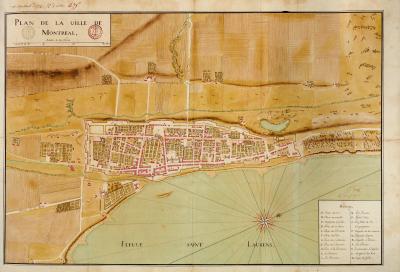In the 1970s, leaders of Montréal’s Chinese community rallied to save a large part of Chinatown from the threat of demolition.
Complexe Guy-Favreau
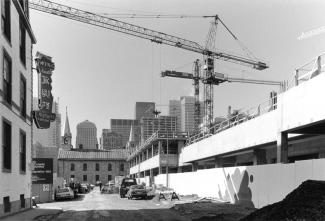
On March 26, 1972, the federal minister of public works, Jean-Eudes Dubé, announced the construction of Complexe Guy-Favreau. Plans for the high-rise towers encroached on the area in which Chinese Montrealers lived and worked, as did a number of other major redevelopment projects begun in the 1970s and ’80s: the Ville-Marie Expressway (1970s), Complexe Desjardins (inaugurated in 1976), and the Palais des congrès (completed in 1983). These initiatives, which the government hoped would promote the eastward expansion of Montréal’s downtown core, threatened to eliminate one-third of Chinatown. A large residential sector, several Chinese businesses, a school, cultural associations, and three Chinese churches were all slated for demolition. In 1981, Pagoda Park came under threat as well as the city set out to expand rue Saint-Urbain.
Sauvons Chinatown (article du journal Le Jour)
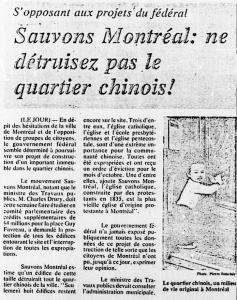
A new beginning
Sauvons Chinatown (vm94-b259-025)

Pagoda Park
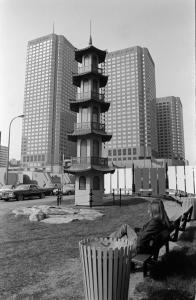
For nearly fifteen years, from 1967 to 1981, Pagoda Park was a significant visual symbol of the Chinese community’s presence in Montréal. Built in 1967 to celebrate Canada’s centennial, the small green space featured a decorative pagoda donated by the owners of Wing’s Noodles. Before the construction of the landmark Chinese arches in the late 1980s, the pagoda was one of the area’s defining features.
CHA, Jonathan. « La représentation symbolique dans le contexte de la mondialisation : L’exemple de la construction identitaire du quartier chinois de Montréal », Journal of the Society for the Study of Architecture in Canada / Journal de la Société pour l’étude de l’architecture au Canada JSSAC /JSÉAC 29, nos 3, 4, 2004, p. 3-18. Également disponible en ligne : patrimoine.uqam.ca/upload/files/publications/CH.pdf
CHAN, Kwok B. Smoke and Fire: the Chinese in Montreal, Hong Kong, The Chinese University Press, 1991, 330 pages.
CHUENYAN LAI, David. Chinatowns: Towns Within Cities in Canada, Vancouver, University of British Colombia Press, 1988, 382 pages.
DEMERS, Clément. « Le nouveau centre-ville de Montréal », Cahiers de géographie du Québec, vol. 27, n° 71, 1983, p. 209-235.
MORRISON, Val M. Beyond Physical Boundaries: The Symbolic Construction of Chinatown, Mémoire (M.A.), Montréal, Université Concordia, 1992, 117 pages.
1970年代,唐人街受到几项大型兴建工程的威胁,如Guy-Favreau联邦大楼、Complexe Desjardins购物商场、Ville-Marie高速公路和蒙特利尔会议中心。为了应对此危机,众多海外华人及其盟友组织了大规模的社区行动以保护唐人街。尽管众人付出了很大努力,最后只有中华天主堂幸存下来,其余的大片住宅区、多家华人商店、一所学校、数间文化协会及两座教堂通通被拆除了。
这些大型兴建工程结束后,唐人街面临被灭绝的威胁。除了失去原有面积之外,人口还急剧下降。为了振兴唐人街,在1980年代初期,社区领袖们成立了委员会,以开发更多城市发展项目,希望增强社区的身份特色。时至今日,在地产开发商的利益驱使下,唐人街的文化遗产正逐渐消亡殆尽。
—
Traduction en chinois simplifié : Serena Xiong et révision (chinois simplifié) : Philippe Liu.
1970年代,唐人街受到幾項大型興建工程威脅如Guy-Favreau聯邦大樓、Complexe Desjardins 購物商場、Ville-Marie 高速公路和滿地可會議中心。為了保存唐人街,眾多海外華人及其盟友組織了大規模的社區行動以保護該地區。儘管衆人付出了很大努力,最後只有中華天主堂倖存。大型住宅區、數家華人商店、一所學校、數間文化協會和兩座教堂通通被拆除了。
這些大型興建結束後,唐人街面臨被滅絕的威脅。除了失去原有面積之外,人口還急劇下降。為了振興唐人街,在1980年代初期,社區領導人成立了委員會,以開發更多城市發展項目,希望增強該區身份特色。時至今日,在土地開發商的利益佔據下,唐人街的文化遺產還是遍體鱗傷。
—
Traductrice : Wai Yin Kwok.

